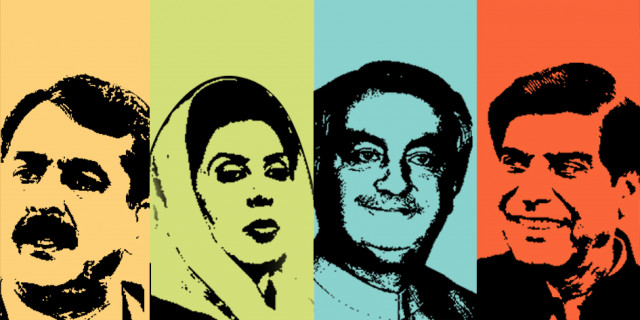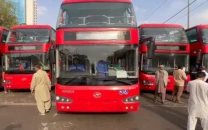Spending bonanza: PPP spent Rs125b to win votes. It failed
Bulk of the spending was concentrated in Punjab; most lawmakers who had big spending were not reelected


You can download the related dataset here.
Through a review of government documents and background interviews, The Express Tribune has found the scale of the PPP’s attempts to win the affections of voters, and the monumental futility of its efforts. The Rs125 billion spent by PPP and their coalition partners ostensibly on development projects during their five years in office is nearly four times larger than the Rs33.8 billion spent by all lawmakers in the preceding 23 years (1985-2008) combined. And yet, six out of the 10 most profligate spenders for the PPP were voted out of office.
A look at the record suggests that there was, at best, massive impropriety and negligence in record-keeping with these development funds, if not outright embezzlement.

You can download the related dataset here.
A total of 5,212 projects were initiated at the behest of lawmakers in their constituencies, and were authorised by prime ministers Yousaf Raza Gilani and his successor Raja Pervez Ashraf, between 2008 and 2013, worth a collective Rs125 billion. Of these, there is absolutely no financial or other record for 1,930 projects, worth Rs20 billion. In a majority of cases, government rules on awarding contracts were not followed, leading to allegations of corruption.
Of the projects commissioned, 1,823 (35%) were never completed, with some having a progress rate of less than 9%. And the Public Works Department as well as the Auditor General of Pakistan conducted special audits on only 330 projects, and even that on orders from the Supreme Court of Pakistan. The government’s top financial watchdog failed to conduct any audits on 1,930 (37%) projects.
The distribution of the projects reflects how desperate the PPP leadership was to use development funding to retain its political foothold in Punjab. Of the Rs125 billion total spending, Rs59.5 billion went to Punjab, Rs31 billion to Sindh, Rs19 billion in Khyber-Pakhtunkhwa, Rs8.7 billion in Balochistan, Rs7.3 billion in the tribal areas and Rs500 million in Islamabad.

You can download the related dataset here.
The spending spree continued on 696 projects even after an order from the apex court to cease such spending in the run-up to the 2013 elections. The Supreme Court ruled that if spending is solely at the discretion of the prime minister or the chief minister of a province, such spending is unconstitutional. In its 38-page judgment in the suo motu case in 2013, it ordered the government to set an objective criteria for approving development projects.
Wasim Sajjad, a lawyer for former PM Raja Pervez Ashraf, appeared to disagree with the Supreme Court’s ruling. “Parliament is the supreme body. If it gives powers to the head of government to releasing discretionary funds, then it is legal,” he said.



The practice of allowing lawmakers to allocate development spending in their constituencies exists in many parts of the world and was only recently banned in the United States, where it is known as ‘earmarking’, or less charitably, ‘pork barrel spending’. The practice was introduced in Pakistan in 1985, under the supposedly non-partisan Parliament of president Ziaul Haq and prime minister Muhammad Khan Junejo, said former law minister SM Zafar.
Ahmad Bilal Mahboob, president of the Pakistan Institute of Legislative Development and Transparency (PILDAT), said that such discretionary funds have “remained a source of blackmailing to members of Parliament. There should be a local government system in place for spending on such public projects, or at least a parliamentary committee, like India has, to oversee smooth running of these projects.”

The idea of constituency-level development projects being given to local governments is a popular one. Nadeem Afzal Gondal of the PPP, who lost his election in Sargodha in 2013 despite spending Rs1 billion, admitted that as many as 40% of the projects in his constituency were not completed. “Look, the existing mechanism for releasing funds to lawmakers promotes corruption in politics. The government should execute the Peoples Works Programmes through a local government system,” he said.

Some lawmakers claim that people were able to get money for fake development projects in their names. One such example is Nasir Shah of the PPP from Quetta who confirmed to The Express Tribune that “two agents took more than Rs2 million by getting fake projects approved using my name. I've approached the National Accountability Bureau to begin investigations.”
Other lawmakers glibly refused to comment. Maulana Fazlur Rahman and his brother Attaur Rahman of the JUI-F spent a collective Rs1.03 billion in development spending and provided no details of what they spent the money on and failed to cooperate with government auditors investigating their projects in fiscal 2012. When contacted about the projects, the JUI-F chief declined to comment.

Similarly, Firdous Ashiq Awan of the PPP (Sialkot), who is under investigation for her spending of Rs1.1 billion on development projects, also declined to comment.

Jamshed Dasti, formerly of the PPP and currently an independent MNA from Muzaffargarh, used up Rs1 billion on 37 projects and did not provide a single report to the government about those projects. He claimed that the 30% of the projects not completed in his constituency were due to the government’s refusal to disburse funds on time.

Fehmida Mirza, former speaker of the National Assembly, used upto Rs1.1 billion but did not provide any details of the projects to the finance ministry. Neither did Faryal Talpur and her husband Munawwar Talpur, who used up Rs1.2 billion for both their constituencies.


Arbab Alamgir and his wife Asma Alamgir, who are facing a NAB investigation for accumulating wealth ‘beyond known sources of income’, consumed Rs1.1 billion under this programme. Both, however, failed to furnish details about their projects and declined to comment.

Former Punjab Chief Minister Manzoor Wattoo and his son Khurram, who consumed Rs1.5 billion, admitted that only 70% of the work on their projects could be completed. Manzoor Wattoo, however, dodged the question when asked why some of his planned projects were stopped by auditors. “Development schemes should not be politicized; however, I can say by and large 80% of the work is fair,” he told The Express Tribune.


When it comes to not keeping track of the money allocated to their discretionary development budgets, it appears that the women in Parliament are not any better than the men.
Sixty women were elected to Parliament on reserved seats in the National Assembly, in addition to many others elected on general seats. Between all of them, they managed to get an estimated Rs10 billion in discretionary development spending allocated to them, but fewer than half of the projects that they allocated funds to can be accounted for by federal auditors.
The majority of the funds were allocated to lawmakers from the Pakistan Peoples Party, most of whom were not reelected in the 2013 elections. The funds utilised by woman lawmakers were more than the amounts allocated to Balochistan, the tribal areas and Islamabad. Yet, the vast majority of them have provided no evidence to the finance ministry that the funds were used for the development projects they had identified, nor even that the projects were undertaken at all.

Some of the lawmakers are now facing inquiries from the Federal Investigation Agency or the National Accountability Bureau. For instance, former information minister Firdous Ashiq Awan of the PPP was allocated Rs1.1 billion in discretionary development funds, but more than half the projects she initiated were not completed. NAB has now started an investigation against her on allegations that she embezzled millions of rupees meant for those projects.
Speaking to The Express Tribune, Awan denied the allegations and claimed that her constituency in Sialkot saw more development during her time than many others. Asked why she was not reelected if that was the case, she said: "Unfortunately, people usually forget the services of legislators during election season."

Former National Assembly Speaker Fehmida Mirza of the PPP was allocated Rs1.1 billion for development projects in her home district of Badin, but nearly 30% of those projects were never completed. Mirza claims that her projects have been reviewed and cleared by federal auditors.

Faryal Talpur of the PPP was allocated Rs780 million and claims to have spent it all on projects in her constituency in Nawabshah, but the Auditor General of Pakistan has no records of such projects. Naseem Akhtar Chaudhry of the PPP, who was ironically the chairperson of the National Assembly Law and Justice Committee, was allocated Rs500 million and has not provided any details about where she spent the money.
Asma Arbab Alamgir of the PPP is facing a NAB investigation after she failed to submit any details of the Rs580 million in discretionary development spending that was allocated to her, but her own personal bank accounts saw their balances increase to much higher levels than in the past. Her husband, Arbab Alamgir, who was former chairman of the National Highway Authority, was also allocated a similar amount and is also under investigation by NAB. Neither were reelected in 2013.

For all the challenges faced by the 10 million Pakistanis who are members of religious minority communities, their elected representatives in Parliament appear to have added another.
More than Rs2.4 billion allocated between 2008 and 2013 by the Zardari Administration for the uplift of these communities cannot be accounted for because the lawmakers placed in charge of spending them have refused to cooperate with government auditors.

An examination by The Express Tribune of government records suggests that there was, at best, massive impropriety and negligence in record-keeping for these development funds, if not outright embezzlement.
Eleven lawmakers, who represent 2.8 million non-Muslim voters, did not provide details of where they spent the money and also refused to cooperate with government auditors investigating their projects.

The funds are part of the Rs125 billion allocated by Prime Ministers Yousaf Raza Gilani and Raja Pervez Ashraf between 2008 and 2013 to lawmakers for discretionary development spending, an amount nearly four times larger than the Rs33.8 billion made in similar allocations in the preceding 23 years (1985 to 2008).
Yet far from admitting the flaws in their bookkeeping, some lawmakers are complaining that the ruling Pakistan Muslim League-Nawaz has not released more such funds to them.

Ramesh Lal of the Pakistan Peoples Party, who received Rs735 million for development projects between 2008 and 2013, complained about the paucity of funds. “It has been two years. We minorities? MNAs [from opposition] have yet to receive our promised funds,” he told The Express Tribune.
Lal, whose schemes were not audited by the Auditor General of Pakistan, claimed that he spent all funds on Sain Saad Raam Mandar in Ghotki, Sasdani Darbar in Mirpur Mathelo, Audhoro Lal in Matiari, Hingal Matha in Lasbela and some other religious places in the country. But he glibly refused to comment on possible misappropriations in these projects.

Another Rs16 million were allocated to Interfaith Harmony Minister Shahbaz Bhatti of the PPP, who was gunned down in 2011 for his support of reforming the blasphemy law, but no records of his development projects were found. Similarly, Akram Masih Gill of the Pakistan Muslim League (Quaid), a PPP coalition partner, got Rs265 million but failed to submit reports on the execution of proposed projects, and was never audited.

A lack of recordkeeping by minority lawmakers appears to be an issue that cuts across party lines. Nelson Azeem of the Pakistan Muslim League Nawaz received Rs60 million for discretionary development spending, also failed to provide records of where that money went, but complained that he received less money during the PPP administration than during the government of his own party.

A small portion of those funds were spent on the renovation of an old convention hall in Sialkot, working women's hostels in Lahore and Gujranwala. He dodged a question when asked where he spent the remaining funds. “All funds were spent on community welfare. Collection of records is difficult at the moment,” Azeem said.

Lal Chand of the PPP got Rs185million in discretionary development funds but did not furnish reports of execution. Mahesh Kumar of the PPP, who got Rs265 million, claimed that he has completed all of his projects, including road networks, water supply schemes, schools, dispensaries, etc. in Tharparkar.

Darshan Punshi of PML-N was allocated Rs131 million, and none of his projects have been audited by the AGP. The same happened with all proposed schemes by Kishan Chand of the PML-Q who got Rs75 million in discretionary development projects. Araish Kumar of PML-N got Rs205 million. Manwar Lal of Muttahida Qaumi Movement got Rs220 million, and Khatu Mal Jewan of PPP, Rs95 million. None of them have submitted adequate documentation of where they spent the money.
You can download the related dataset here.

When it comes to discretionary development spending allocations for elected officials, it pays to be the party chief. A review of government documents by The Express Tribune showed that party chiefs far outspent their backbench colleagues in parliament.
The worst offenders were Fazlur Rahman and Ataur Rahman, the two brothers who lead the Jamiat Ulema-e-Islam (JUI-F). Of the Rs2 billion allocated to development projects identified by JUI-F lawmakers between 2008 and 2013, over 70%, or Rs1.4 billion, was spent by these two politicians. During that time, there were 16 lawmakers in parliament from the JUI-F, but the remaining 14 had to divide up Rs600 million between them for their constituencies.
Not only did the JUI-F leaders fail to share the federal government’s largesse with the rest of their party members, they also failed to cooperate with federal auditors when asked about where they spent the money in 2012.
Yet despite apparently starving their fellow party members’ constituencies of funds, JUI-F legislators appear to believe that the Rahman brothers were justified in their behaviour.
“Both [Fazlur Rehman and Attaur Rehman] are the best at fighting for the rights of their constituencies compared to the more lethargic MPs who may have been inactive both within parliament and outside it,” said Jan Achakzai of the JUI-F. “In our system, if you are not proactive lobbyist as an MP, you cannot get a penny’s worth of projects [for your constituency] from the bureaucracy.”
The Rahman brothers are by no means alone in dominating their parties’ allocations for federal discretionary development spending. The Sherpao faction of the Pakistan Peoples Party (PPP-Sherpao) was allocated Rs160 million during the Zardari Administration, of which Rs140 million went to projects identified by the party’s eponymous leader Aftab Ahmad Khan Sherpao.Of the Rs7.5 billion allocated to Awami National Party (ANP) lawmakers between 2008 and 2013, party leader Asfandyar Wali Khan got Rs980 million, which is more than three times the amount allocated to the next biggest recipient of federal funding.
During that period, Rs18.3 billion were allocated to federal legislators from the Pakistan Muslim League Quaid (PML-Q), of which party leaders Chaudhry Shujaat Hussain and Chaudhry Pervaiz Elahi used up Rs800 million.
Despite several attempts, none of these party chiefs responded to The Express Tribune’s requests for comment.
Between 2008 and 2013, the federal government spent Rs125 billion on discretionary development projects identified by members of the National Assembly. That amount is nearly four times as much as the Rs33 billion spent by all lawmakers in the preceding 23 years (1985-2008) combined.
Under Prime Ministers Yousaf Raza Gilani and Raja Pervaiz Ashraf, a total of 5,212 projects identified by MNAs were authorised, of which 1,823 (35%) were never completed, and some had a progress rate of less than 9%. The auditor general of Pakistan has conducted special audits on 330 of these projects, and even that happened after a Supreme Court order.












1726134115-0/BeFunk_-(41)1726134115-0-208x130.webp)






COMMENTS
Comments are moderated and generally will be posted if they are on-topic and not abusive.
For more information, please see our Comments FAQ